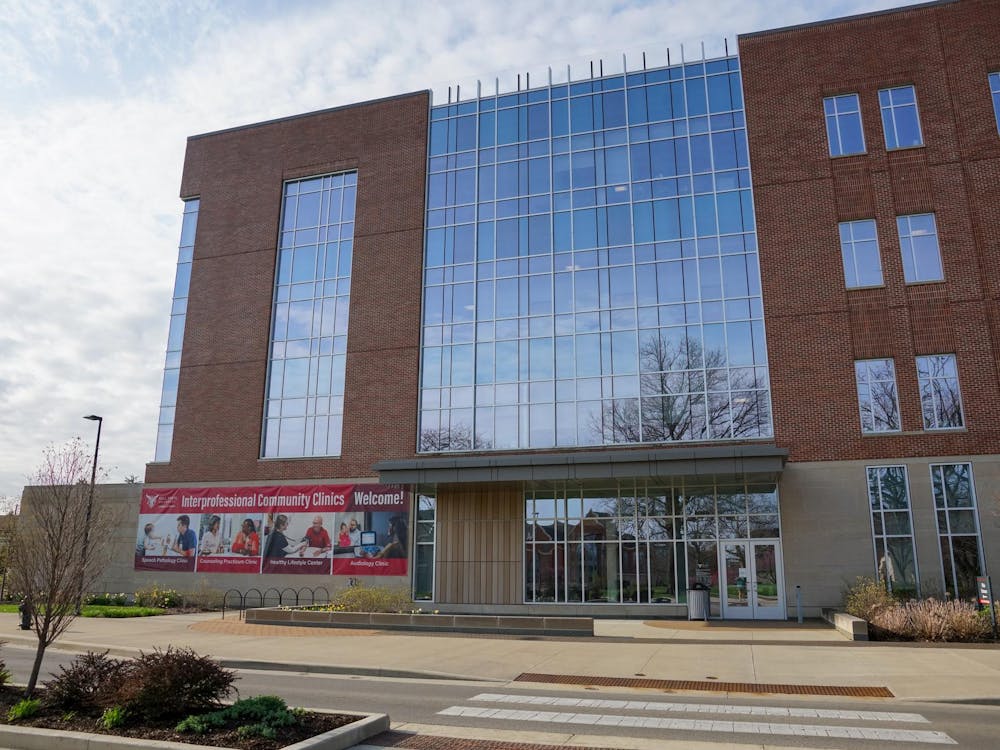The Edmund F. and Virginia B. Ball Endowed Chair schooled her audience on what it means to be a Foley artist who creates sound for cinema and television in Art and Journalism Building Room 175 April 9.
“Sound paints an environment,” telecommunications professor Vanessa Ament said.
Ament arrived at Ball State in 2014. She worked as a Foley artist for iconic movies before beginning teaching. Foley is the name for the sounds created behind the scenes and in a studio for movies and television.
Ament took a philosophical approach to the art of Foley in her talk.
“What’s really important to understand is we are charged with the task of solving problems. We don’t just create beautiful sounds,” she said. “Those sounds are not always used as what they are. It’s about imagining what you want the sound to be. Then you have Foley.”
Ament inserted comedy into her speech as well.
“I’m amazed at the people who came tonight,” she said. “Hopefully some of you will stay awake. I’m running on no coffee, so if I can do it, you can do it.”
Ament and her assistants shared clips of her on the "Late Show with David Letterman" in 1985. She stood, tiny, next to Letterman’s tall frame while she taught him to recreate the sounds of brass knuckles and pistols clapping onto the table with perfect timing and how to make the sound of bones crunching by mercilessly snapping celery stalks in half.
Ament also shared clips of films she had previously worked on, including “Edward Scissorhands,” “Platoon” and “Die Hard." As the audience watched Edward try to pick up dinner silverware with his literal scissor-hands, Ament explained the process behind the clink-clink of the metal-on-metal sound.
The hands Johnny Depp used in the film were actually mechanical and made buzzing, whirring and very audible robotic vibrations.
“The scissor-hands had their own character,” she said. “But that sound can’t be used on film.”
Ament said any sound or noise they created had to be carried over, even when Depp wasn’t on camera. The family is at the dinner table, and as the camera cuts back and forth between Edward and the family, Foley is what’s utilized to keep that off-camera character alive.
As other clips played throughout the evening, Ament pointed out many of the often overlooked sounds that movie audiences don’t realize come from a studio. In “Platoon,” the Foley crew had to recreate the sounds of military bodies smacking into wild foliage, the footsteps of the large units of soldiers and uniforms rubbing against gear and skin. All this occurred even before the opening credits were through.
Ament took a few moments to explain why tasks like that could be so daunting.
“We have to be mindful of the storytelling. The audience can get distracted just by reading the credits. The sound needs to be a little hyper-real to keep the attention,” she said.
Not only do Foley artists have to be aware of what they’re using, but also how they’re using it. The same tool can make different sounds when used in conjunction with different supplemental objects — the same way a water glass will produce different tones when different levels of water are placed in it.
“It’s really important to understand resonance changes depending on what you’re working with and what you’re up against,” she said.
To prove her point, Ament retrieved a door hinge off a fully-stocked props table in the room and demonstrated the difference in sounds when she placed the hinge against a table, her luggage and when she held it in the air and bent against nothing but itself.
“The whole intent and purpose of Foley is to be the organic and sonic sound of the character,” she said while bending the hinge toward and away from her audience, comparing the organic sound to Auto-Tune and a live vocal performance, or digital music versus a vintage vinyl. “It’s never going to replace it. It will never be the same. That’s why there are still Foley artists working.”
As she brought up new tools and methods of technology, Ament kept returning to one solid point: “The world goes on without you.”
Creating sound is an art form, the same as singing, dancing or painting. But you have to know and understand where you fit, she said.
“Nobody does it all beautifully,” Ament said. “You know what you’re good at. You need to know where you’re weak and where you’re not as great, and you need to have people with you who are.”
She also pointed out that students still have their whole lives ahead of them, despite the pressure and rush they often feel to move forward in their lives.
“Aging is an amazing thing, so don’t fear it. It’s wonderful to be able to be more reflective and not take yourself so seriously,” she said. “You get to your 50s and think, ‘I really did OK.’ Then you get to your 60s and think, ‘I just said that out loud and now everybody knows.’”
Ament took a minute to reflect. Despite all the work she has under her belt, she still believes in the power of being one small person in a great big world.
“In the course of human history, you’re not that important, and I can’t tell you what a wonderful feeling that is,” she said.




